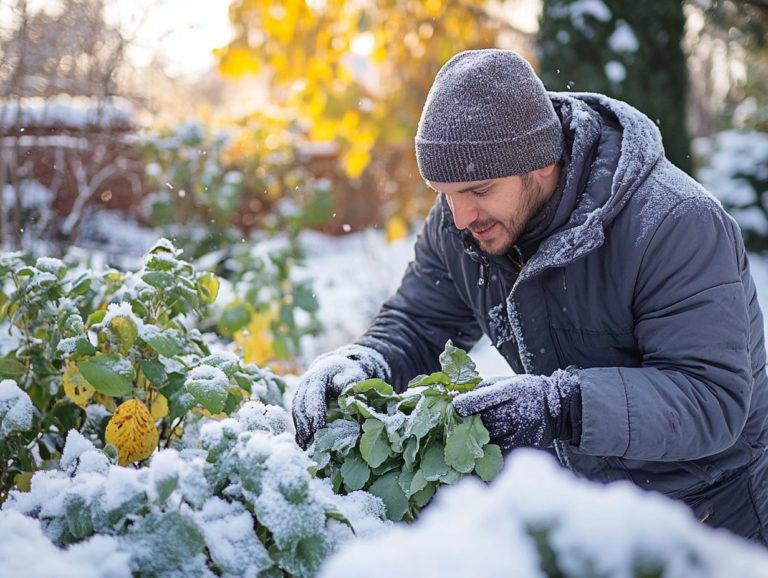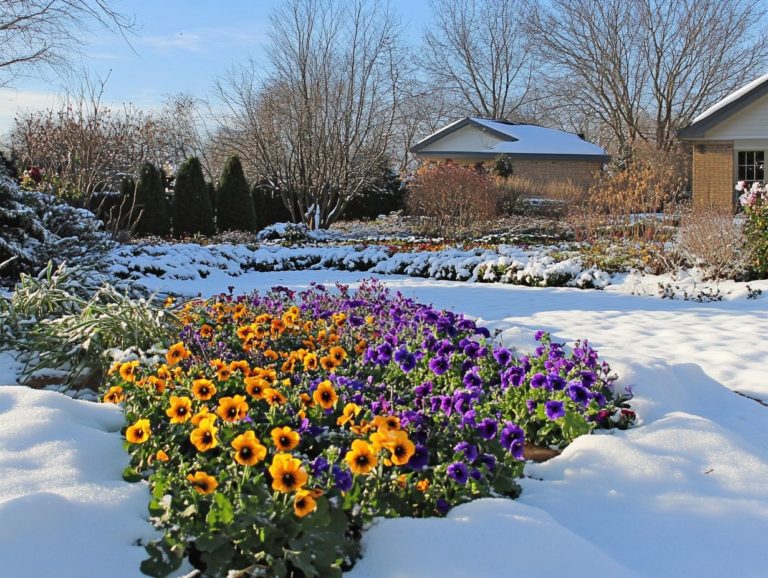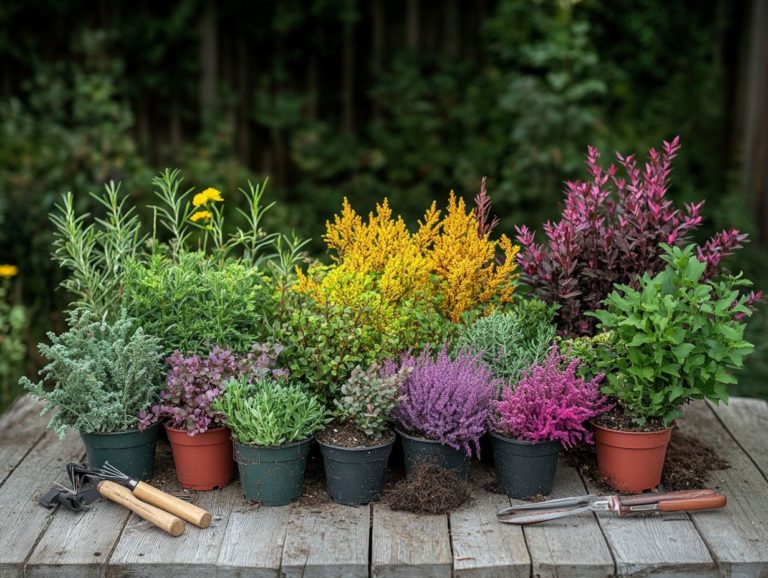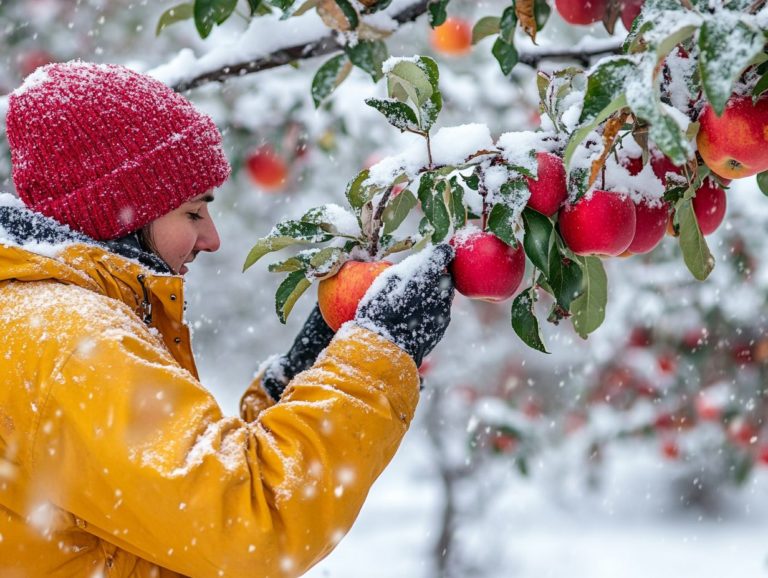Herbs That Grow Well in Cold Climates
Cold climates may present a challenge for garden enthusiasts, but with the right selection of winter herbs, you can cultivate a vibrant green space even amidst the chill!
This article showcases 15 resilient herbs that grow well in the cold that thrive in frosty conditions, ranging from aromatic rosemary to invigorating mint. You’ll uncover their unique benefits, along with expert tips for successful cultivation and practical advice on harvesting and storage.
You will also learn how to use these flavorful herbs in your daily cooking. Prepare to elevate your cold-weather gardening experience!
Contents
Key Takeaways:
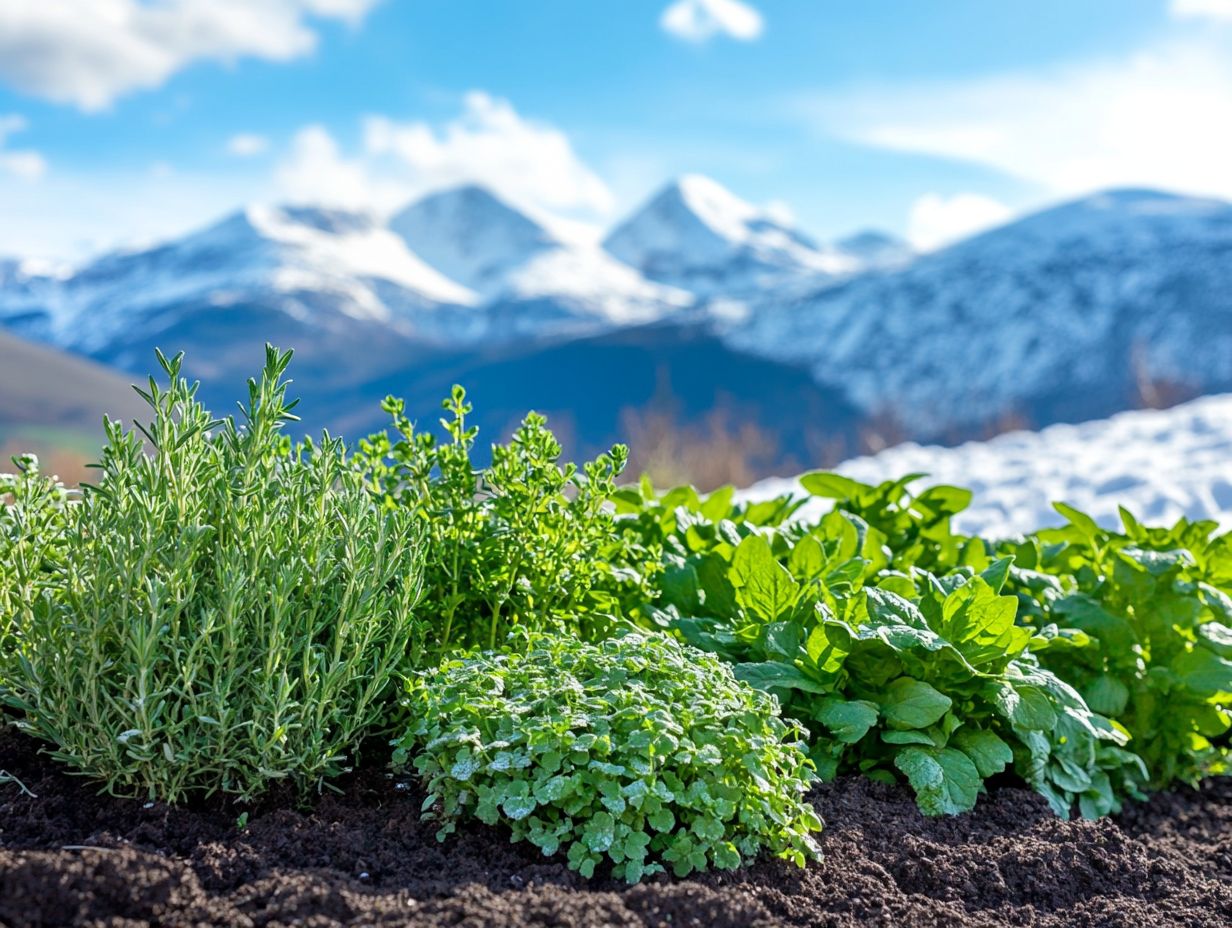
- Certain herbs, such as rosemary, thyme, and sage, thrive in cold climates, making them ideal choices for gardeners in these regions.
- Growing herbs in cold climates can provide numerous benefits, including fresh and flavorful ingredients, natural pest control, and a year-round supply of herbs.
- To successfully grow herbs in cold climates, it is important to choose the right varieties, provide proper care and protection, and use effective harvesting and storing techniques.
1. Rosemary
Rosemary (Rosmarinus officinalis) is an aromatic gem that you’re bound to love for both its culinary uses and medicinal benefits. It s easy to see why this herb graces so many gardens across specific climate zones defined by the USDA that indicate how well certain plants grow, particularly zones 4, 5, and 6. Thriving in sunny spots, rosemary is a true survivor, resilient enough to brave colder temperatures.
This makes it a fantastic choice for your winter cooking and herbal remedies. With its needle-like leaves, rosemary not only infuses dishes like roasted meats and vegetables with a distinctive flavor but also shines in various herbal teas, which are known for their medicinal properties.
To ensure optimal growth, you’ll want to cultivate rosemary in well-drained soil and make regular pruning a part of your routine to encourage that lovely bushy appearance. These herb growing tips will help maximize your success!
Beyond the kitchen, rosemary is celebrated for its anti-inflammatory and antioxidant properties, making it a beloved staple in traditional medicine. You ll appreciate how adaptable it is; growing rosemary in pots allows for easy relocation and protection during extreme weather, maximizing its potential all year round.
2. Thyme
Thyme is a truly versatile and aromatic herb, celebrated in the culinary world and esteemed for its medicinal properties. It s no wonder that it has become a staple in many herb gardens, particularly in USDA zones like 5 and 6, where herbs that grow well in the cold flourish.
This delightful herb boasts a variety of types, including English thyme, lemon thyme, and creeping thyme, each bringing its own unique flavors and fragrances to a diverse range of dishes, from succulent roasted meats to vibrant salads. Cooks frequently pair thyme with tomatoes, garlic, and other Mediterranean staples, showcasing its remarkable adaptability across various cuisines.
Cultivating thyme in your herb garden is a breeze. It thrives in well-drained soil and loves basking in full sunlight. With a bit of proper care, it can withstand winter conditions, allowing you to savor the freshness of your herbs long after the frost has claimed the garden.
3. Sage
Sage, a robust perennial herb, is your go-to for both culinary delights and medicinal benefits, making it an invaluable asset for herb gardens in colder climates, particularly in USDA zones 4 and 5, where you can also find plants for wildlife habitat in cold climates that thrive.
The distinctive, earthy flavor of sage brings a savory depth to a myriad of dishes, from rich meat roasts to delectable sauces, and it pairs beautifully with ingredients like garlic and onion. Ideally, sage flourishes in well-drained soil with ample sunlight, so securing a sunny spot in your garden is essential for its growth.
Whether you use it fresh or dried, its aromatic leaves elevate soups, stews, and even pastries with delightful nuances. To ensure this hardy herb survives the winter months, it s wise to mulch around the base to protect the roots, reducing frost damage while retaining moisture.
With the right care, you can enjoy a thriving sage plant year after year.
Start your winter herb garden today and enjoy the fresh flavors all season long!
4. Chives
Chives are a cherished herb, renowned for their fresh flavor and delicate onion-like taste. They are an excellent choice for your cooking and gardening for beauty. In USDA zones that support cold-hardy herbs, chives thrive even in harsh winter conditions.
These versatile perennials can elevate a variety of dishes, from soups and salads to baked potatoes and omelets, adding a subtle kick that transforms the overall flavor profile. Consider protective measures such as mulching or planting in raised beds to keep them healthy and vibrant during the colder months. These strategies can provide insulation against freezing temperatures.
With their remarkable ability to regrow each spring, chives not only delight your palate but also serve as a charming addition to your garden, offering both beauty and utility throughout the seasons. Don t wait start growing your chives today for their fresh flavor all season long!
5. Mint
Mint, with its delightful fragrance and versatility, enriches a myriad of culinary dishes and beverages. Gardeners in USDA zones that support cold-hardy herbs, like zones 6 and 7, cherish it for its resilience, allowing it to flourish in varied conditions.
This herb comes in several enticing varieties, including spearmint, peppermint, and chocolate mint, each offering distinct flavors and aromas. Beyond its culinary charm, mint also presents a wealth of medicinal benefits, aiding digestion and alleviating headaches, making it a valuable asset in your herbal remedy toolkit.
If you re considering cultivating this delightful herb, ensure you provide well-drained soil and plenty of sunlight. Explore container gardening to keep its vigorous growth in check. With these thoughtful strategies, growing mint can be a rewarding pursuit for both culinary aficionados and health-conscious individuals alike, making it one of the top annual herbs to consider.
6. Oregano
Oregano stands out as a hardy perennial herb, celebrated for its robust flavor profile. It s a must-have ingredient in Mediterranean cuisine and a beloved choice for herb gardens, especially in USDA zones where cold-hardy herbs thrive, like zone 5 and zone 6.
With varieties such as Greek, Italian, and Mexican oregano, each type adds its unique flair to your culinary creations. From traditional pasta sauces to modern meat marinades, oregano significantly enhances flavors across a spectrum of dishes.
If you’re looking to cultivate this herb in colder climates, choose well-draining soil and provide ample sunlight. Positioning the plants in sheltered areas will give them the best chance. During winter, protect your oregano with mulch or frost cloths (special fabric that protects plants from frost); this simple step can boost its survival odds, allowing this cherished herb to thrive year after year.
7. Lavender
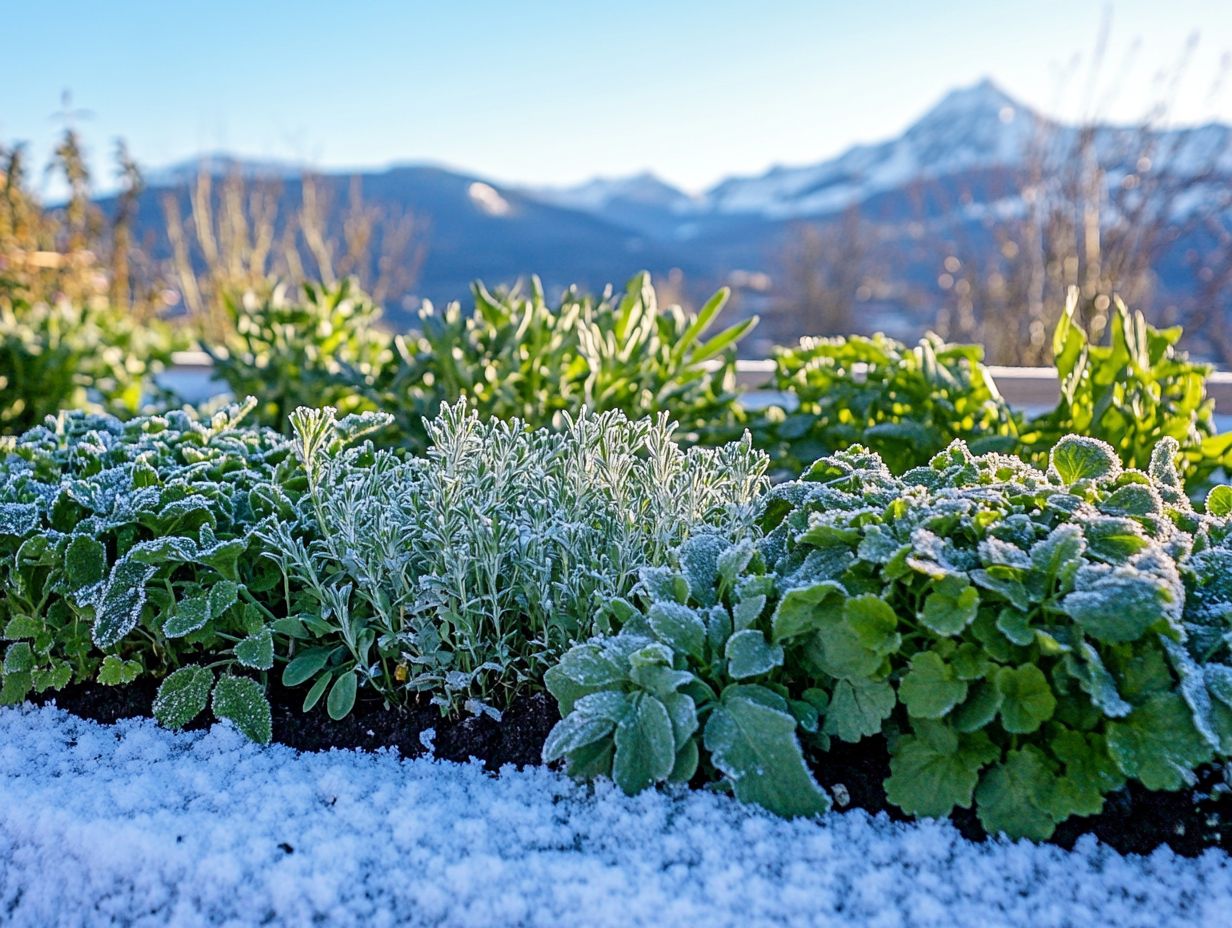
Lavender makes for a stunning addition to your herb garden, offering not only a delightful aroma but also a range of culinary uses, especially in desserts and teas. Thriving in USDA zones 5 and 6, it can withstand cooler temperatures making it a perfect choice for cold-hardy herb enthusiasts.
You ll find that different types of lavender like English, French, and Spanish each bring unique flavors and fragrances that can truly elevate your culinary creations. Its versatility stretches beyond sweet dishes; the floral notes of lavender can create a delightful contrast in savory recipes as well, enhancing richer ingredients beautifully.
To ensure your lavender plant flourishes, provide well-drained soil and plenty of sunlight aim for at least six hours a day. As winter rolls in, a protective layer of mulch can safeguard the roots against severe frost, while occasional pruning will help maintain its shape and encourage vibrant growth come spring.
8. Lemon Balm
Lemon Balm is a fragrant herb that enchants with its citrusy aroma, making it a delightful addition to your teas and cooking. It is also a valuable herb for medicinal uses. Thriving in USDA zones suitable for cold-hardy herbs, particularly zones 5 and 6, it gracefully withstands the chill of winter climates.
This versatile herb enhances the flavors of your salads and marinades. It serves as a valuable ally in herbal remedies, often helping to reduce stress and aid digestion.
If you’re considering growing it, choose a sheltered location with well-drained soil to boost its resilience during harsh winters. Regular pruning encourages bushier growth and keeps those leaves tender.
Having a cloche (a protective cover for plants) or row cover at the ready can shield your young plants from frost. This ensures that your lemon balm not only survives but thrives, delivering a generous harvest season after season.
9. Parsley
Parsley, a nutrient-rich herb, stands out for its versatile culinary applications and vibrant flavor. It s a beloved staple in herb gardens across various USDA zones, including those that welcome cold-hardy herbs like zones 6 and 7, where it can thrive even in winter.
This herb comes in delightful forms, such as curly leaf and flat-leaf varieties, and is brimming with vitamins A, C, and K. These vitamins contribute to improved bone health and bolster immune function.
To ensure robust growth during the colder months, regularly water your plants and ensure that the soil is well-drained. Additionally, choose a location that basks in ample natural light to keep your cherished parsley vibrant and full of flavor throughout the winter season.
10. Chamomile
Chamomile, celebrated for its calming properties and enchanting aroma, is a favored herb in both teas and cooking. It flourishes beautifully in herb gardens within USDA zones that embrace cold-hardy plants, particularly thriving in zones 5 and 6, where it can weather the chill of winter.
But chamomile isn’t just for soothing teas; this versatile herb elevates salads, desserts, and even savory dishes with its distinct flavor. It also offers a wealth of health benefits. In the realm of herbal medicine, it has long been valued for its ability to ease anxiety, encourage restful sleep, and support digestion.
If you’re keen on growing chamomile in colder climates, focus on well-drained soil and a sunny spot to significantly boost its growth. Adding mulch will safeguard the roots during harsh winter months, while consistent watering during dry spells keeps your plants robust and flourishing, ready for harvest for both culinary delights and medicinal uses.
11. Fennel
Fennel, with its distinctive flavor and aromatic charm, serves as a versatile herb in various cooking applications. If you’re situated in USDA zones that favor cold-hardy herbs, particularly zones 6 and 7, you ll find that fennel can thrive even in cooler temperatures.
This incredible herb adds a bold, unique flavor that will elevate your dishes. It also boasts an impressive array of health benefits, including digestive support and antioxidant properties.
For those looking to cultivate fennel in colder climates, choose a sheltered location that basks in full sunlight. Preparing well-drained soil is also essential.
Timing is everything; understanding when to sow seeds or transplant seedlings can greatly enhance growth. Get started now to ensure a thriving harvest this season, highlighting both the culinary versatility of fennel and its nutritional benefits.
12. Dill
Dill, with its delicate feathery leaves and aromatic seeds, is a cherished herb in many kitchens. It s celebrated for its distinctive flavor in both pickling and cooking. It thrives particularly well in USDA zones, which are areas defined by the U.S. Department of Agriculture that indicate which plants can grow in certain climates. Look for zones 5 and 6.
Whether you’re a gourmet chef or a passionate home cook, you ll find dill elevating your dishes. From creamy sauces to vibrant salads, it truly showcases its versatility. If you’re considering cultivating this delightful herb, you ll love to know that dill loves well-drained soil and a sunny spot, making it easy to add to your garden or containers.
To keep your dill thriving through the colder months, try using strategies like mulching and protecting your plants against fierce winds. If you’re keen on enjoying its fresh flavor year-round, indoor growing techniques can help you maintain that unique taste, ensuring you can savor dill no matter the season.
13. Cilantro
Cilantro, known for its vibrant flavor and distinct aroma, is a must-have in your culinary repertoire. This popular herb flourishes in herb gardens across USDA zones that accommodate cold-hardy varieties, including zone 5, making it essential for culinary enthusiasts like you.
Often featured in dishes ranging from zesty salsa to aromatic Thai curries, cilantro adds a fresh, zesty kick that elevates your meals. To ensure your cilantro thrives, choose well-drained soil enriched with organic matter and place it in a sunny spot where it can soak up at least six hours of sunlight each day.
As winter approaches and temperatures dip, act now to protect your plants! Cover them with frost cloths or move potted cilantro indoors, allowing it to endure the colder months while still providing you with fresh herbs throughout the year.
14. Catnip
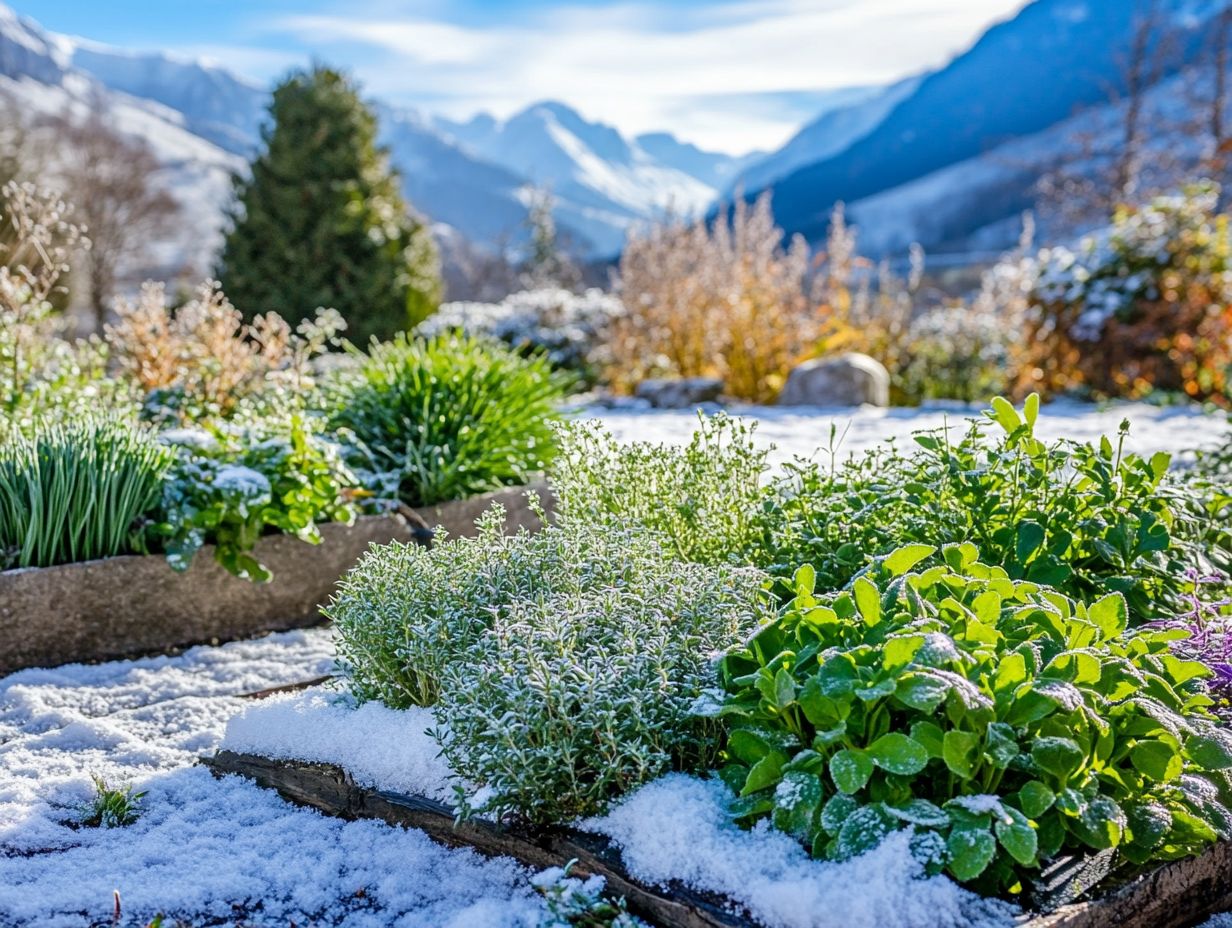
Catnip, often celebrated for its enchanting effects on cats, is also a delightful herb that can thrive in your herb garden. It does particularly well in USDA zones that support cold-hardy varieties, such as zones 5 and 6, where its resilience allows it to brave the winter chill.
This charming plant not only brings playful joy to your feline friends but also transforms into a soothing herbal tea for you, known for its calming properties.
If you’re considering adding this versatile herb to your garden, choose a sunny location with well-drained soil. For those in colder climates, a layer of mulch around the base during winter and adequate watering during the growing season will keep your catnip flourishing.
By following these straightforward tips, you ll enrich both your beloved pets and your tea time with the many delightful pleasures that catnip has to offer.
15. Echinacea
Echinacea, celebrated for its impressive medicinal properties, is a herb that comes back each year and thrives in herb gardens found in USDA zones that support cold-hardy plants, particularly in zones 4 and 5. Its remarkable ability to endure winter makes it a valuable asset for any herbalist.
This extraordinary plant adds a splash of vibrant color to your garden while delivering a plethora of health benefits, including immune system support and anti-inflammatory properties. As you contemplate cultivating echinacea, remember it flourishes best in well-draining soil and requires minimal watering once established, making it a great choice even for those with limited gardening expertise.
Choosing a sunny spot encourages vigorous growth and flowering, ensuring a bountiful yield. By applying mulch during harsh winters, you can protect your echinacea while enhancing its resilience in colder climates.
What Are the Benefits of Growing Herbs in Cold Climates?
Growing herbs in cold climates offers a wealth of benefits. You can cultivate perennial herbs for cold-climate gardens that can survive in cold weather and contribute to a sustainable garden. Imagine the delight of enjoying fresh ingredients for cooking, along with various medicinal properties that can enhance your health and well-being.
These resilient plants thrive in lower temperatures and require less maintenance than their delicate counterparts. Varieties such as rosemary, thyme, and chives are especially suited for cooler environments, delivering robust flavors that elevate your meals. Beyond their culinary appeal, these hardy herbs play essential roles in traditional remedies, boasting antimicrobial and anti-inflammatory properties.
By incorporating cold-hardy herbs into your daily life, you can relish the deliciousness they bring to your meals while promoting biodiversity in your garden.
How to Maximize Your Herb Garden in Cold Weather
Curious about how to grow garlic in cold climates? Successfully growing herbs in these conditions calls for strategic planning and effective techniques. Cold frames provide an extra layer of protection, while container gardening allows you to manage microclimates with ease.
Embracing these approaches enables you to cultivate a thriving garden, even when conditions are less than ideal. Cold frames are fantastic for trapping warmth and shielding young plants from harsh winds and frost, making them a smart choice for your efforts. Container gardening lets you move your herbs to sunnier spots during chillier months, optimizing their growth.
Don’t forget to adopt protective strategies like mulching and using frost fabrics, which shield your herbs from freezing temperatures. This ensures you’ll enjoy a bountiful harvest come spring.
What Are the Best Practices for Harvesting and Storing Herbs in Cold Climates?
Harvesting and storing herbs in cold climates requires a refined approach to ensure freshness and flavor shine through. Mastering the best harvesting techniques not only caters to your culinary needs but also sets you up for successful long-term storage during winter. Certain practices are common for herb preservation.
Timing is everything. Aim to harvest your herbs in the morning, after the dew has evaporated but before the sun reaches its peak. This sweet spot maximizes essential oil content, which is key for flavor and medicinal properties.
For storage, consider methods like drying your herbs in a cool, dark place or freezing them in airtight containers to preserve their potency. You can also store some herbs in oil or vinegar, allowing their flavors to infuse while extending shelf life. This way, the unique characteristics of each herb remain beautifully intact, ready to elevate your dishes during the colder months.
Which Herbs Are Not Suitable for Cold Climates?
Some herbs simply don t thrive in cold climates, especially annual herbs that can t handle freezing temperatures. It s essential to identify these plants when planning your herb garden for the colder USDA zones.
Take basil, cilantro, and dill, for instance. They often fall victim to frost, making them less than ideal choices for gardeners braving chilly winters. Their growth cycles lack the resilience needed to withstand extreme temperature drops.
Instead, consider opting for heartier perennials like thyme, mint, and chives. These hardy herbs endure colder weather and enhance the flavor of your meals, ensuring that your gardening efforts are both satisfying and rewarding, even when the frost sets in.
How Can One Incorporate Cold Climate Herbs into Cooking and Daily Routines?
Incorporating cold climate herbs into your cooking elevates flavors and harnesses their health benefits. For those interested in maximizing their garden potential, learning how to grow salad greens in cold climates can help these hardy plants easily enhance your everyday meals and herbal remedies.
Just picture this: freshly chopped thyme or rosemary transforming your savory baked goods! The aroma alone will transport you. If you re feeling adventurous, try adding sage to roasted vegetables for a delightful flavor revelation.
When you add herbs like parsley or dill to your salads, you not only boost their nutritional value but also introduce exciting textures and colors. Simple adjustments like these can enrich your meals while providing a wealth of health benefits, from boosting immunity to aiding digestion.
Frequently Asked Questions
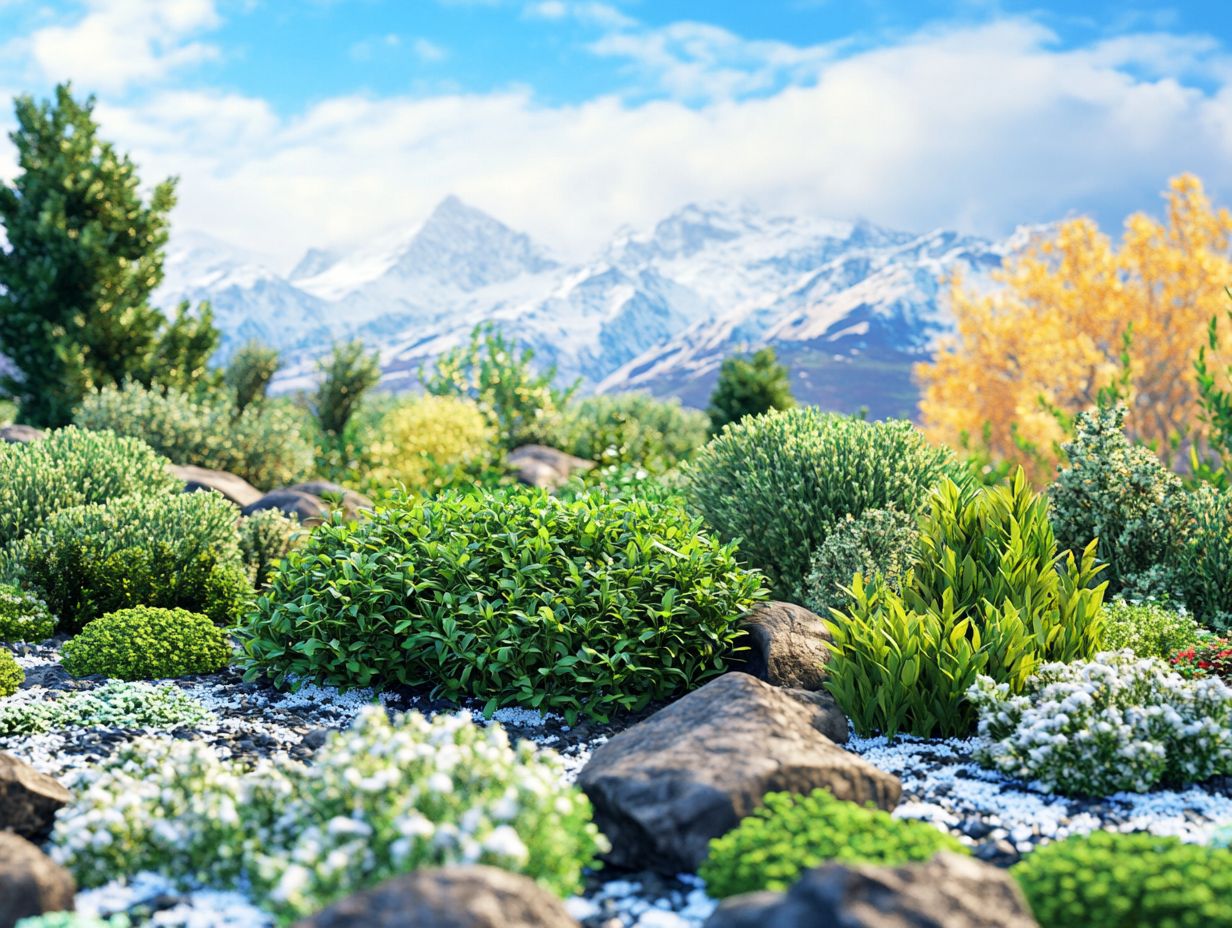
What are some herbs that grow well in cold climates?
Some herbs that thrive in cold climates include rosemary, thyme, sage, chives, parsley, and mint.
How do I grow herbs in cold climates?
To grow herbs in cold climates, choose cold-hardy varieties that can survive low temperatures, and plant them in well-draining soil. For more information, you can explore what herbs thrive in cold climates and consider using containers that can be brought indoors during extreme cold spells.
Can I grow herbs in the winter in cold climates?
Yes, but it depends on how cold it gets. Some herbs, such as rosemary and chives, can survive mild winters. If you experience harsh winters, it may be best to grow herbs indoors during that time.
What are the benefits of growing herbs in cold climates?
Growing herbs in cold climates provides a fresh supply of herbs for cooking and adds greenery to your winter garden. To learn more about this process, check out how to grow winter herbs successfully. It can also save you money from buying herbs at the store.
Do herbs need special care in cold climates?
Yes, herbs in cold climates may require extra care, like protecting them from frost and ensuring they get enough sunlight. It’s important to research the specific needs of each herb for successful growth.
Are there any herbs that can survive extreme cold climates?
Yes, a few herbs are extremely hardy and can survive in very cold climates. These include thyme, rosemary, sage, and chives. If you’re interested in expanding your garden, you might also want to explore what vegetables grow best in cold climates. Always check the specific hardiness zone of the herb before planting.
Start incorporating these herbs into your meals today and enjoy the health benefits!



